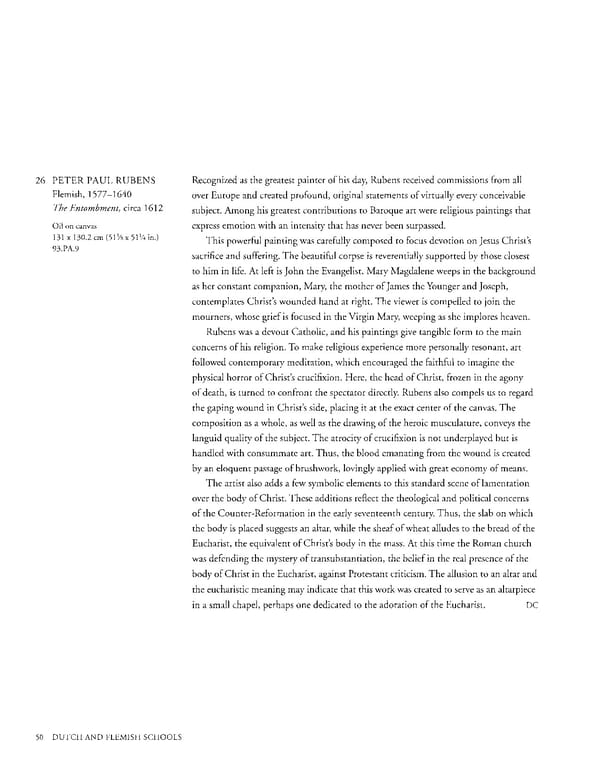26 PETER PAUL RUBENS Recognized as the greatest painter of his day, Rubens received commissions from all Flemish, 1577-1640 over Europe and created profound, original statements of virtually every conceivable The Entombment, circa 1612 subject. Among his greatest contributions to Baroque art were religious paintings that Oil on canvas express emotion with an intensity that has never been surpassed. 131 x 130.2 cm (51 x 51¼ in.) This powerful painting was carefully composed to focus devotion on Jesus Christ's 93.PA.9 sacrifice and suffering. The beautiful corpse is reverentially supported by those closest to him in life. At left is John the Evangelist. Mary Magdalene weeps in the background as her constant companion, Mary, the mother of James the Younger and Joseph, contemplates Christ's wounded hand at right. The viewer is compelled to join the mourners, whose grief is focused in the Virgin Mary, weeping as she implores heaven. Rubens was a devout Catholic, and his paintings give tangible form to the main concerns of his religion. To make religious experience more personally resonant, art followed contemporary meditation, which encouraged the faithful to imagine the physical horror of Christ's crucifixion. Here, the head of Christ, frozen in the agony of death, is turned to confront the spectator directly. Rubens also compels us to regard the gaping wound in Christ's side, placing it at the exact center of the canvas. The composition as a whole, as well as the drawing of the heroic musculature, conveys the languid quality of the subject. The atrocity of crucifixion is not underplayed but is handled with consummate art. Thus, the blood emanating from the wound is created by an eloquent passage of brushwork, lovingly applied with great economy of means. The artist also adds a few symbolic elements to this standard scene of lamentation over the body of Christ. These additions reflect the theological and political concerns of the Counter-Reformation in the early seventeenth century. Thus, the slab on which the body is placed suggests an altar, while the sheaf of wheat alludes to the bread of the Eucharist, the equivalent of Christ's body in the mass. At this time the Roman church was defending the mystery of transubstantiation, the belief in the real presence of the body of Christ in the Eucharist, against Protestant criticism. The allusion to an altar and the eucharistic meaning may indicate that this work was created to serve as an altarpiece in a small chapel, perhaps one dedicated to the adoration of the Eucharist. DC 50 DUTCH AND FLEMISH SCHOOLS
 Masterpieces of the Getty Museum: Paintings Page 50 Page 52
Masterpieces of the Getty Museum: Paintings Page 50 Page 52